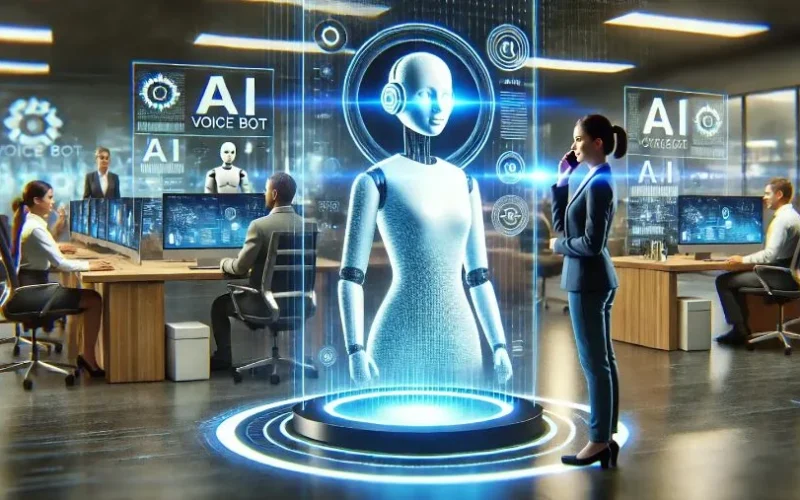Is AI finally better at customer service than humans? With advancements in voice bots, many businesses are turning to AI to improve their customer support.
Voice bots never get tired, can handle multiple queries at once, and cost far less than human operators. However, can they truly replace the personal touch of human interaction?
While voice bots have come a long way, the answer isn’t simple. Humans excel at empathy and complex problem-solving—two areas where AI still struggles.
The key question is, can bots be as safe, reliable, and effective as humans? Let’s find out.
What Are AI Voice Bots?
AI voice bots are automated systems that interact with users through voice commands, using advanced technologies like Natural Language Processing (NLP) and machine learning. These bots are capable of understanding spoken language and responding in a conversational way, which makes them perfect for customer support tasks like answering common questions or troubleshooting issues.
Over the past few years, AI voice bots have advanced significantly. Companies like Amazon (with Alexa) and Google (with Google Assistant) have shown just how sophisticated these systems can become. Many businesses now use voice AI to provide 24/7 customer service, manage high call volumes, and offer quicker responses than human agents.
Yet, there’s more to this conversation. It’s not just about what voice bots can do, but also about how well they do it compared to humans.
Is Voice AI Safe for Businesses?
When adopting AI-driven solutions, one question often arises: is voice AI safe? Safety in this context refers not just to data privacy but also to customer satisfaction and brand reputation.
Voice AI bots, like any technology, need to handle sensitive customer data securely. Businesses must ensure that the AI systems they deploy comply with privacy laws and are free from vulnerabilities that could expose them to security breaches.
But there’s also the question of customer trust. A bot that sounds too robotic can erode trust, while one that mimics human voices too closely might feel unsettling to customers. The challenge lies in finding a balance where voice bots are helpful without feeling impersonal or eerie.
Human vs. AI Voice Bots: The Pros and Cons
When comparing humans and AI voice bots, each has its strengths and weaknesses. Let’s break them down.
AI Voice Bots: Advantages
AI voice bots excel in areas where efficiency is key. They can handle multiple conversations at once, respond immediately, and provide answers to simple, repetitive queries. For businesses, this can mean substantial cost savings, especially when compared to paying a team of human customer service agents to work around the clock.
Additionally, AI bots are not subject to the limitations of human workers—they don’t take breaks, don’t get tired, and never need time off. This means they can offer 24/7 customer support, which is invaluable for companies that operate globally or deal with high volumes of customer inquiries.
Voice bots also can “learn” from every interaction. Through machine learning, they can improve over time, providing increasingly accurate and helpful responses.
Human Agents: Advantages
However, human agents have their own set of strengths. People are naturally better at understanding context, empathy, and emotional nuances. A frustrated customer, for example, may not respond well to an AI bot’s scripted responses, but a human agent can listen and provide a compassionate, personalized solution.
Humans are also much better at handling complex or unique issues. When the conversation goes off-script, or when a situation requires creative problem-solving, human agents can think critically, whereas bots may struggle.
AI Voice Bots: Limitations
Despite their efficiency, AI voice bots are far from perfect. They can falter when conversations deviate from their programming or when they encounter unfamiliar phrases. This lack of flexibility can frustrate users, especially when they’re dealing with a non-standard problem that requires nuanced understanding.
Furthermore, the more “human” bots try to sound, the higher the chance they will venture into what some call the “uncanny valley.” This term refers to how people can become uncomfortable when robots or AI seem almost human but not quite right, creating a sense of eeriness.
Human Agents: Limitations
On the other hand, human agents can become overwhelmed, especially during peak times. High volumes of calls can lead to long wait times, and overworked agents might not perform at their best. Plus, the cost of hiring, training, and maintaining a human customer service team is far higher than setting up a voice bot system.
The Balance: AI and Humans Working Together
The most successful customer service models today are hybrids. AI voice bots handle the repetitive, simple tasks—like answering FAQs, checking order statuses, or scheduling appointments—while human agents step in when more personalized assistance is required.
For businesses, this hybrid model provides the best of both worlds: the efficiency and cost-effectiveness of AI, combined with the empathy and problem-solving skills of human agents. For customers, it means faster service for simpler issues and human support when they need it most.
Companies that seamlessly integrate voice bots and human agents are seeing the most success. This model allows for scalable customer service without sacrificing the personal touch.
Are Voice Bots Beating Humans?
So, are voice bots truly beating humans? The answer depends on how you define “beating.” If the goal is efficiency and scalability, then yes, voice bots outperform humans in many ways. They are faster, more cost-effective, and can handle multiple conversations simultaneously.
But if the goal is customer satisfaction, especially in complex or emotional situations, humans still have the upper hand. Bots can’t replace empathy, intuition, or the nuanced understanding of human behavior—at least not yet.
The future of customer service likely lies in collaboration between AI and human agents, creating a system where the strengths of each complement the other. This hybrid model ensures that businesses can provide efficient, scalable service without losing the human touch that customers still crave.
Conclusion
The debate about whether AI voice bots can replace humans in customer service is ongoing. While AI technology is advancing rapidly, it’s clear that voice bots still have limitations. For now, the best solution is to combine the speed and efficiency of bots with the empathy and creativity of human agents.
As technology continues to evolve, we may see a future where AI can handle even the most complex and emotional interactions. But until then, the smartest approach is to use both AI and human agents to ensure customer service that is both efficient and personal.
This balance between AI and human interaction is what will define the next generation of customer service experiences.

